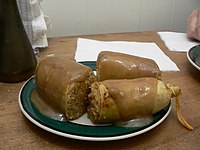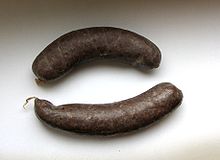Kishka (food): Difference between revisions
No edit summary |
|||
| Line 30: | Line 30: | ||
==Jewish cuisine== |
==Jewish cuisine== |
||
'''Kishke''' or '''kishka''' ([[Yiddish language|Yiddish]] and [[Hebrew language|Hebrew]]: קישקע, ''kishke'', from Slavic ''kishka'', literally "gut" or "[[intestine]]"), also known as '''stuffed derma''', is a Jewish dish traditionally made from [[beef]] intestine (which has not been legal in US since 1958) stuffed with flour or [[matzo]] meal, [[schmaltz]] and spices.<ref>[http://dictionary.reference.com/browse/kishka Kishke and stuffed derma in Jewish cookery] in ''Random House Unabridged Dictionary'' (2006) and ''The American Heritage Dictionary of the English Language'' (4th ed., 2006).</ref><ref>[http://www.zeek.net/702food/ "Kishke, culture, and celebrity chefs"], an interview on zeek.net, February 2007</ref><ref name=ansky/> In modern cooking, edible synthetic [[casing (sausage)|casing]]s often replace the beef intestine.<ref>[http://www.jewishmag.com/72mag/kishke/kishke.htm Kishke recipe]</ref> Kishke is a common addition to [[Ashkenazi Jews|Ashkenazi]]-style [[cholent]].<ref>Daniel Rogov's [http://www.stratsplace.com/rogov/israel/feasting_cholent.html "Feasting on cholent"]</ref> |
|||
{{main|Kishke (Jewish food)}} |
|||
Prepared kishke is sold in some [[kosher]] [[butcher]]ies and [[delicatessen]]; in [[Israel]] it is available in the frozen-food section of most supermarkets. Non-traditional varieties include kishke stuffed with rice and kishke stuffed with diced chicken livers and ground gizzards.<ref name=ansky>Ansky, Sherry, ''Hamin'' ('''Hebrew'''; English title ''Tscholent''), Keter Books, Jerusalem, 2008.</ref> There are also [[vegetarian]] kishke recipes.<ref>[http://www.angelfire.com/pa2/passover/recipes-pesach/kishka-recipe-kishke-vegetarian.html Vegetarian kishke recipe for Passover]</ref><ref>[http://yedidya.org.il/recipes/kishka.htm Vegetarian kishka], recipe from yedidya.org.il</ref> |
|||
The [[Ashkenazi Jews|Ashkenazic]] [[Jewish cuisine|Jewish dish]] called ''[[kishke (Jewish food)|kishke]]'' is traditionally made from a kosher beef intestine stuffed with [[matzo]] meal, rendered fat ([[schmaltz]] or beef fat), and spices.<ref>http://www.zeek.net/702food/</ref> Blood and pork are not used, as they are forbidden by [[kashrut]] dietary rules. |
|||
The stuffed sausage is usually placed on top of the assembled cholent and cooked overnight in the same pot. Alternatively it can be cooked in salted water with vegetable oil added or baked in a dish, and served separately with flour-thickened gravy made from the cooking liquids.<ref name=ansky/><ref>Claudia Roden, ''The Book of Jewish Food: An Odyssey from Samarkand to New York'', Alfred Knopf, New York (1996), p. 129.</ref> |
|||
In recent times edible synthetic [[casing (sausage)|casing]]s often replace the beef intestines.<ref>http://www.jewishmag.com/72mag/kishke/kishke.htm</ref> Homemade [[helzel]], a sausage-like dish consisting of chicken neck skin stuffed with a flour-based mixture, is sometimes referred to as ''false kishka''. |
|||
Kishka is available in some [[kosher]] [[butcher]]s and [[delicatessen]]; in [[Israel]] it is available in the frozen-foods section of most supermarkets. |
|||
==See also== |
==See also== |
||
Revision as of 11:55, 13 February 2012
It has been suggested that Kishke (Jewish food) be merged into this article. (Discuss) Proposed since January 2012. |

Kishka or kishke (Slovene: kašnica; Belarusian кішка, kishka; Polish: kiszka; Romanian chişcă Silesian krupńok; Yiddish kishke; Hebrew קישקע) refers to various types of sausage or stuffed intestine with a filling made from a combination of meat and meal, often a grain. The dish is popular across Eastern Europe as well as with immigrant communities from those areas. It is also eaten by Ashkenazi Jews who prepare their version according to kashrut dietary laws. The name itself is Slavic in origin, and literally means "gut" or "intestine".[1]
Description

One Eastern European kishka type is kaszanka, a blood sausage made with pig's blood and buckwheat or barley, with pig intestines used as a casing.[2] Similar to black pudding, it is traditionally served at breakfast.
Kishkas can also be made with an organ meat, such as liver and various grain stuffings. The cooked kishke can range in color from grey-white to brownish-orange, depending on how much paprika is used and the other ingredients. There are also vegetarian kishka recipes.[3][4]
The sausages are popular in areas of the Midwestern United States, where many Poles emigrated. There are numerous mail order companies and delis that sell various kishkas. As blood is often used as an ingredient, kishkas are considered an acquired taste.
Greater Bialystok Area Kiszka
Is usually made in a way very similar to the Jewish Kishke (80% of the residents of Bialystok before World War II were Jewish), but in the majority of cases, pig intestines are used, and ground potatoes are the main ingredient.
"Who Stole the Kishka?"
"Who Stole the Kishka?" (originally spelled "Who Stole the Keeshka?") is a traditional polka tune, composed in the 1950s by Walter Solek and recorded and played by various bands. One popular version was familiar to American radio audiences from a 1963 recording by Grammy award-winning polka artist Frankie Yankovic.
A portion of the song includes three of various lyrics having to do with Polish foods, depending on who performs the song:
You can have my shinka
Take my sweet krusczyki
Take my plump pierogi
You can even have my chernika
Take my long kielbasa
The verse ends with the pleading refrain "but please bring back my kishka." Shinka is ham, while chernika refers to blueberries.
Jewish cuisine
Kishke or kishka (Yiddish and Hebrew: קישקע, kishke, from Slavic kishka, literally "gut" or "intestine"), also known as stuffed derma, is a Jewish dish traditionally made from beef intestine (which has not been legal in US since 1958) stuffed with flour or matzo meal, schmaltz and spices.[5][6][7] In modern cooking, edible synthetic casings often replace the beef intestine.[8] Kishke is a common addition to Ashkenazi-style cholent.[9]
Prepared kishke is sold in some kosher butcheries and delicatessen; in Israel it is available in the frozen-food section of most supermarkets. Non-traditional varieties include kishke stuffed with rice and kishke stuffed with diced chicken livers and ground gizzards.[7] There are also vegetarian kishke recipes.[10][11]
The stuffed sausage is usually placed on top of the assembled cholent and cooked overnight in the same pot. Alternatively it can be cooked in salted water with vegetable oil added or baked in a dish, and served separately with flour-thickened gravy made from the cooking liquids.[7][12]
See also
References
- ^ Frederic Gomes Cassidy, Joan Houston Hall (1985), “kishka” and “kishke” in Dictionary of American Regional English, p 228, Harvard University Press, ISBN 0674205197
- ^ Polish Pork Primer by Dana Bowen Issue #105 Saveur
- ^ Vegetarian Kishka recipe
- ^ Vegetarian Kishka
- ^ Kishke and stuffed derma in Jewish cookery in Random House Unabridged Dictionary (2006) and The American Heritage Dictionary of the English Language (4th ed., 2006).
- ^ "Kishke, culture, and celebrity chefs", an interview on zeek.net, February 2007
- ^ a b c Ansky, Sherry, Hamin (Hebrew; English title Tscholent), Keter Books, Jerusalem, 2008.
- ^ Kishke recipe
- ^ Daniel Rogov's "Feasting on cholent"
- ^ Vegetarian kishke recipe for Passover
- ^ Vegetarian kishka, recipe from yedidya.org.il
- ^ Claudia Roden, The Book of Jewish Food: An Odyssey from Samarkand to New York, Alfred Knopf, New York (1996), p. 129.
External links
- Definition from Merriam-Webster [1]
